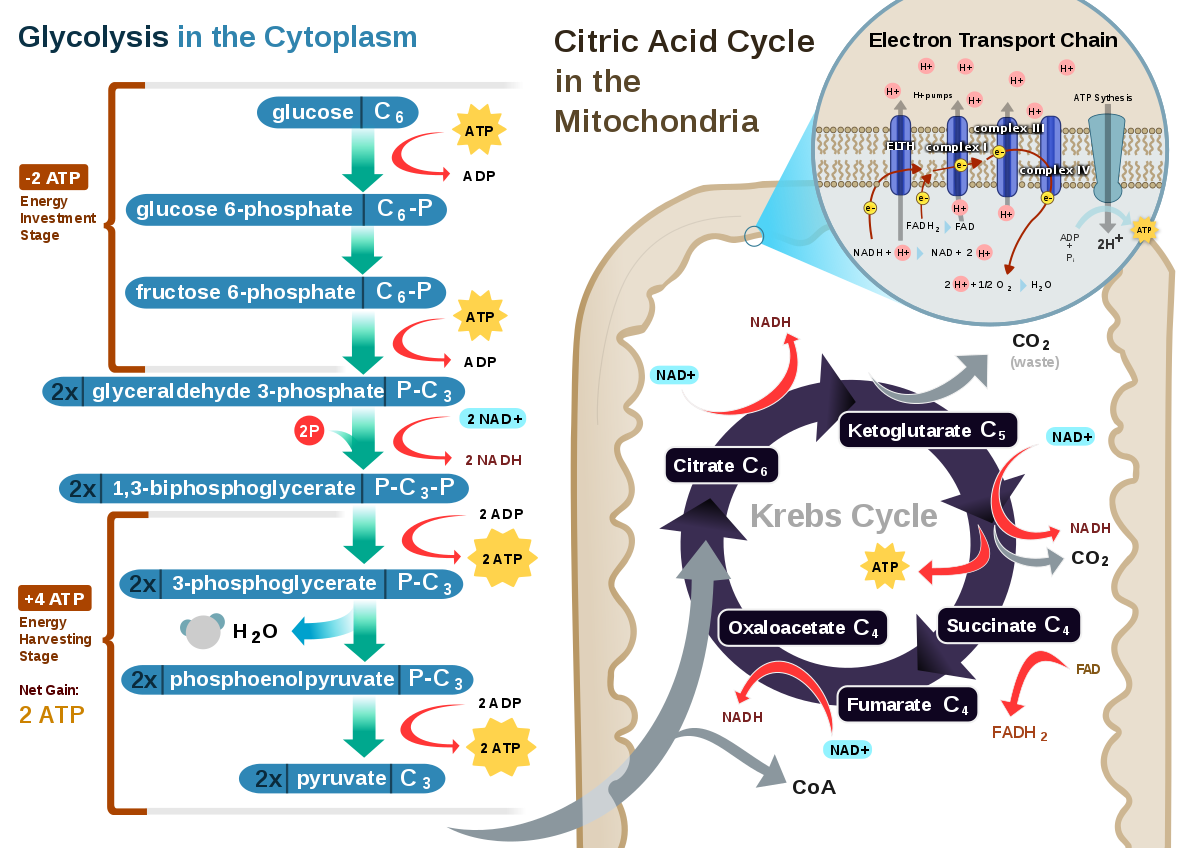
How is glucose converted to ATP?
Answer
495.6k+ views
Hint: Cellular respiration is a set of metabolic processes that all living cells go through in order to release energy by converting biochemical energy from food into adenosine triphosphate-ATP. Metabolism is a sequence of chemical reactions that are carried out in order to keep the cells in an organism alive. These can be classified into two groups: Catabolism is the breakdown of molecules in order to obtain energy. Anabolism is the process of the cells producing all of the substances they require.
Complete answer:
Cellular respiration converts glucose into ATP. Glucose is entirely oxidised to \[C{O_2}\] and water, releasing energy that is stored in the form of ATP. Aerobic respiration converts one molecule of glucose into \[38\] ATP molecules. The cytoplasm and mitochondria are where aerobic respiration takes place. Glycolysis, Krebs cycle, and oxidative phosphorylation through the electron transport system are the processes of cellular respiration.
The lysis or splitting of sugars is referred to as glycolysis. One molecule of the 6-carbon chemical glucose is broken down into two molecules of \[3\]-carbon pyruvic acid during glycolysis. This can happen whether there is oxygen in the cytoplasm or not. We end up with two pyruvic acid molecules, two ATP molecules, and two NADH electron transporting molecules in total.
The Krebs cycle, also known as the tricarboxylic acid cycle and the citric acid cycle, is a metabolic cycle that occurs in the body. The generated pyruvic acid is transported to the mitochondrial matrix and transformed to acetyl CoA. Two molecules of ATP are created after a number of processes. In addition, two chemicals are produced: nicotinamide adenine dinucleotide (NADH) and flavin adenine dinucleotide (\[FAD{H_2}\]). They help with electron transport for the next phase.
Oxygen is required for the electron transport system and oxidative phosphorylation. High-energy electrons are passed on through a chain of electron carriers such as NADH, resulting in an electron gradient. ATPase uses oxidative phosphorylation to convert ADP to ATP.

Additional information:
The energy currency of the cell is ATP, or adenosine triphosphate. ATP is an organic molecule made up of phosphate groups, adenine, and the sugar ribose that provides energy for a variety of metabolic reactions in cells.
Note:
Cellular respiration is divided into two categories based on oxygen demand: aerobic and anaerobic respiration. The burning or oxidation of glucose in the presence of oxygen to release energy is known as aerobic respiration (ATP). Glycolysis, Krebs' cycle, and the electron transport system are the three phases in the aerobic respiration process. Anaerobic respiration, often known as fermentation, is a kind of cellular respiration in which respiration occurs without the presence of oxygen.
Complete answer:
Cellular respiration converts glucose into ATP. Glucose is entirely oxidised to \[C{O_2}\] and water, releasing energy that is stored in the form of ATP. Aerobic respiration converts one molecule of glucose into \[38\] ATP molecules. The cytoplasm and mitochondria are where aerobic respiration takes place. Glycolysis, Krebs cycle, and oxidative phosphorylation through the electron transport system are the processes of cellular respiration.
The lysis or splitting of sugars is referred to as glycolysis. One molecule of the 6-carbon chemical glucose is broken down into two molecules of \[3\]-carbon pyruvic acid during glycolysis. This can happen whether there is oxygen in the cytoplasm or not. We end up with two pyruvic acid molecules, two ATP molecules, and two NADH electron transporting molecules in total.
The Krebs cycle, also known as the tricarboxylic acid cycle and the citric acid cycle, is a metabolic cycle that occurs in the body. The generated pyruvic acid is transported to the mitochondrial matrix and transformed to acetyl CoA. Two molecules of ATP are created after a number of processes. In addition, two chemicals are produced: nicotinamide adenine dinucleotide (NADH) and flavin adenine dinucleotide (\[FAD{H_2}\]). They help with electron transport for the next phase.
Oxygen is required for the electron transport system and oxidative phosphorylation. High-energy electrons are passed on through a chain of electron carriers such as NADH, resulting in an electron gradient. ATPase uses oxidative phosphorylation to convert ADP to ATP.

Additional information:
The energy currency of the cell is ATP, or adenosine triphosphate. ATP is an organic molecule made up of phosphate groups, adenine, and the sugar ribose that provides energy for a variety of metabolic reactions in cells.
Note:
Cellular respiration is divided into two categories based on oxygen demand: aerobic and anaerobic respiration. The burning or oxidation of glucose in the presence of oxygen to release energy is known as aerobic respiration (ATP). Glycolysis, Krebs' cycle, and the electron transport system are the three phases in the aerobic respiration process. Anaerobic respiration, often known as fermentation, is a kind of cellular respiration in which respiration occurs without the presence of oxygen.
Recently Updated Pages
A man running at a speed 5 ms is viewed in the side class 12 physics CBSE

State and explain Hardy Weinbergs Principle class 12 biology CBSE

Which of the following statements is wrong a Amnion class 12 biology CBSE

Two Planoconcave lenses 1 and 2 of glass of refractive class 12 physics CBSE

The compound 2 methyl 2 butene on reaction with NaIO4 class 12 chemistry CBSE

Bacterial cell wall is made up of A Cellulose B Hemicellulose class 12 biology CBSE

Trending doubts
What are the major means of transport Explain each class 12 social science CBSE

Which are the Top 10 Largest Countries of the World?

Draw a labelled sketch of the human eye class 12 physics CBSE

Explain sex determination in humans with line diag class 12 biology CBSE

The pH of the pancreatic juice is A 64 B 86 C 120 D class 12 biology CBSE

Give 10 examples of unisexual and bisexual flowers




